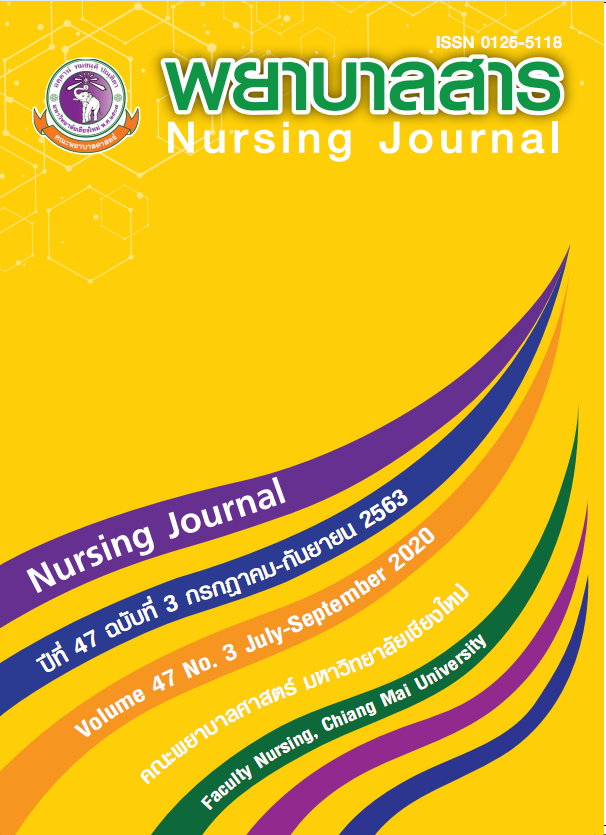Quality Improvement of Discharge Planning for Patients with Acute Myocardial Infarction in Cardiac Care Unit, Nakornping Hospital, Chiang Mai Province
Keywords:
Quality Improvement, Discharge Planning, Acute Myocardial InfarctionAbstract
Patient Discharge planning is an important process to prepare patients from acute to transitional stages in order to enhance patients’ self-care and self-management when discharged from the hospital. This study aimed to improve the quality of discharge planning for patients with acute myocardial infarction in the Cardiac Care Unit, Nakornping Hospital, Chiang Mai Province by using the FOCUS-PDCA process improvement method. Population included 14 registered nurses working in the Cardiac Care Unit, Nakornping Hospital. The instruments used in the study were the check list of discharge planning practices of professional nurses, developed by the researcher, Thitinut Akkadechanunt and Somjai Sirakamon based upon the literature review. The content validity index was 0.98 and the reliability was 1.00. The focus group interview guidelines regarding problems, barriers and recommendations for discharge planning was approved by three experts. Data was analyzed by descriptive statistics and content analysis.
The study results revealed that:
- The mean score of discharge planning practices for patients with acute myocardial infarction after using the FOCUS-PDCA process improvement method in the first, second and sixth week were
86.31, 92.98 and 96.32 respectively.
- The problems and barriers to patient discharge planning were 1) Nursing staff: high workload, lack of monitoring and encouraging for discharge planning. 2) Patients: language barrier during communication and the understanding of the disease and practices after receiving teaching and advice and 3) Discharge planning process: many steps in the discharge planning process which takes time to record all the information. The recommendations for patient discharge planning were: 1) Head nurses should always monitor, encourage and promote nurses in planning for patients discharge regularly and 2) Nurses should coordinate discharge planning among stakeholders both in the hospital and the community.
These results of the study will be useful for nurse administrators to develop strategies in discharge planning and continuously monitor the discharge planning for patients with acute myocardial infarction among nurses in the Cardiac Care Unit at Nakornping Hospital.
References
Baratloo, A., Rahmati, F., Forouzanfar, M.M., Hashemi,E., Motamedi, M. and Safari, S. (2015). Evaluation of Performance Indexes of Emergency Department. Iranian Journal of Emergency Medicine (2015); 2(1): 33-38.
Beirami, H.J., Mousazadeh,Y., Pourranjbari, S. and Jafarabadi, M.A. (2015). The Effects of FOCUS-PDCA Methodology on Emergency Department Patient Disposition In dex. Iranian Journal of Emergency Medicine (2015); 2 (2): 76-81
Cherlin, E. J., Curry, L. A., Thompson, J. W., Greysen, S. R., Spatz, E., Krumholz, H. M., & Bradley, E. H. (2012). Features of high quality discharge planning for patients following acute myocardial infarction. Society of General Internal Medicine, 28(3), 436-443. doi:10.1007/s11606-012-2234-y
Graham, J., Gallagher, R., & Bothe, J. (2012). Nurses’ discharge planning and risk assessment: behaviours, understanding and barriers. Journal of Clinical Nursing, 22 (15-16), 2338-2346, doi:10.1111/jocn.12179
Horwitz, L.I., Moriarty,J. P., Chen, C. J.P. , Fogerty, R.L., Brewster,U. C.,Kanade, S., Ziaeian, B., Jenq, G.Y. and Krumholz, H.M. (2013). Quality of Discharge Practices and Patient Understanding at an Academic Medical Center. JAMA Intern Med. 2013; 173(18):1715-1722. doi:10.1001/
jamainternmed.2013.9318, Published online August 5, 2013. http: // www.who.int/mediacentre/factsheets/fs317/en/http:// www.nextstepincare.org/.../Provider/Provider_Hospital_Discharge_Plan...http:// www.thaincd.com/document/hot%20news/ World Heart Day %202558.pdf (In Thai)
Kaewkum, U. (2014). Quality improvement of preoperative preparation for patients undergoing spinal surgery, Chiang Mai neurological hospital. Independent Study. Master degree of Nursing Administration. Graduate School of Chiangmai University. (In Thai)
Phanthung, N. , Chaiyawan, H. and Saengsuwanto, N .(2016). Campaign on World Heart Day Campaign Issue Year 2016. Bureau of Non-Communicable Diseases, Department of Disease Control, Ministry of Public Health. Retrieved from
Pongcharoen, C. (2012). Teaching Documentation Unit 12 Principles and Techniques for Nursing New Admission, Distribution, Relocation and Referral Record symptoms. Boromarajonani College of Nursing Suphan Buri, 4 September 2012. Retrieved fro m Preoperative Patients, Phrae Hospital. Independent Study. Master degree of Nursing Administration. Graduate School of Chiangmai University. (In Thai)
Sanathum,Y. (2012).). Quality Improvement of Information Provision Process for
Saxena, S., Ramer, L. and Ira A. Shulman. (2004). A comprehensive assessment program to improve blood-administering practices using the FOCUS-PDCA model. Tranfusion Volume 44, September 2004.
Tamikkaborworn, S. (2011). Holistic Nursing: A Case Study. Bangkok: Thanapress Company Limited. (In Thai)
United Hospital Fund. (2011). For Providers:Hospital Discharge Planning –First Steps with Family Caregivers. Retrieved from
Wagner, K. C. (2002). FOCUS PDCA: A process improvement (PI) to ol for libraries. Journal of Hospital Librarianship, 2(2), 93-97. doi:10.1300/J186v02n02_09
Watts, R., Gardner, H., & Pierson, J. (2005). Factors that enhance or impede critical care nurses’ discharge planning practices. Intensive & Critical Care Nursing, 21 (5), 302-313. doi:10.1016/j.iccn.2005.01.005
Word Health Organization. (2015). Cardiovascular diseases (CVDs). Retrieved from
Downloads
Published
How to Cite
Issue
Section
License
บทความที่ได้รับการตีพิมพ์เป็นลิขสิทธิ์ของวารสารพยาบาลสาร
ข้อความที่ปรากฏในบทความแต่ละเรื่องในวารสารวิชาการเล่มนี้เป็นความคิดเห็นส่วนตัวของผู้เขียนแต่ละท่านไม่เกี่ยวข้องกับมหาวิทยาลัยเชียงใหม่ และคณาจารย์ท่านอื่นๆในมหาวิทยาลัยฯ แต่อย่างใด ความรับผิดชอบองค์ประกอบทั้งหมดของบทความแต่ละเรื่องเป็นของผู้เขียนแต่ละท่าน หากมีความผิดพลาดใด ๆ ผู้เขียนแต่ละท่านจะรับผิดชอบบทความของตนเองแต่ผู้เดียว






